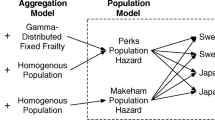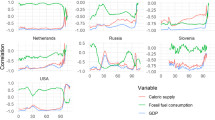Abstract
The majority of countries in Africa and nearly one-third of all countries require mortality models to infer the complete age schedules of mortality that are required to conduct population estimates, projections/forecasts, and other tasks in demography and epidemiology. Models that relate child mortality to mortality at other ages are important because almost all countries have measures of child mortality. A general, parameterizable component model (SVD-Comp) of mortality is defined using the singular value decomposition and calibrated to the relationship between child or child/adult mortality and mortality at other ages in the observed mortality schedules of the Human Mortality Database. Cross-validation is used to validate the model, and the predictive performance of the model is compared with that of the log-quadratic (Log-Quad) model, which is designed to do the same thing. Prediction and cross-validation tests indicate that the child mortality–calibrated SVD-Comp is able to accurately represent the observed mortality schedules in the Human Mortality Database, is robust to the selection of mortality schedules used for calibration, and performs better than the Log-Quad model. The child mortality–calibrated SVD-Comp can be used where and when child mortality is available but mortality at other ages is unknown.






Similar content being viewed by others
Notes
The first left singular vector of the HMD residuals are massaged slightly to ensure all elements of v are positive and smooth.
If desired, k is chosen so that the resulting mortality schedule matches an input value 45q15.
This is the expression used to model the first residual in Wilmoth’s age/period/cohort model, shown in Eq. (2).
SVDs are calculated using the svd function in the base package of R.
This ensures that the whole data cloud is separated from the origin by an amount that is substantially greater than the typical value of each logit-transformed mortality rate, and therefore each age group has roughly equivalent leverage in the optimization required to identify the first new dimension of the SVD. The remaining dimensions are effectively identified on a centered data cloud.
The SVD-Comp life tables are constructed using standard procedures in one-year age groups with nax values taken from the HMD life tables. The Log-Quad life tables are constructed using R code provided by Wilmoth et al. (2012) in five-year age groups.
For components i ∈ {2, 3, 4}, kernel smoother with Gaussian kernel and bandwidth = i + 1 for ages i and older.
References
Alexander, M., Zagheni, E., & Barbieri, M. (2017). A flexible Bayesian model for estimating subnational mortality. Demography, 54, 2025–2041.
Bell, W. R. (1997). Comparing and assessing time series methods for forecasting age-specific fertility and mortality rates. Journal of Official Statistics, 13, 279–303.
Bourgeois-Pichat, J. (1962). Factor analysis and sex-age-specific death rates: A contribution to the study of the dimensions of mortality. United Nations Population Bulletin, 6, 147–201.
Bourgeois-Pichat, J. (1990). Application de l’analyse factorielle à l’étude de la mortalitié [Application of factor analysis to the study of mortality]. Population (French ed.), 45, 773–802.
Bozik, J. E., & Bell, W. R. (1987). Forecasting age specific fertility using principal components. In Proceedings of the American Statistical Association, Social Statistics Section (pp. 396–401). Alexandria, VA: American Statistical Association.
Brass, W. (1971). On the scale of mortality. In W. Brass (Ed.), Biological aspects of demography (pp. 69–110). London, UK: Taylor and Francis.
Carter, L. R., & Lee, R. D. (1986). Joint forecasts of U.S. marital fertility, nuptiality, births, and marriages using time series models. Journal of the American Statistical Association, 81, 902–911.
Clark, S. J. (2001). An investigation into the impact of HIV on population dynamics in Africa (Doctoral dissertation). University of Pennsylvania, Philadelphia, PA. Retrieved from https://repository.upenn.edu/dissertations/AAI3031652, and available at http://www.samclark.net/pdfs/clark-2001_phd_an-investigation-into-the-impact-of-hiv-on-population-dynamics-in-africa.pdf
Clark, S. J. (2015). A singular value decomposition-based factorization and parsimonious component model of demographic quantities correlated by age: Predicting complete demographic age schedules with few parameters (Working paper). Retrieved from https://arxiv.org/abs/1504.02057
Clark, S. J., Jasseh, M., Punpuing, S., Zulu, E., Bawah, A., & Sankoh, O. (2009, May). INDEPTH model life tables 2.0. Paper presented at the annual meeting of the Population Association of America, Detroit, MI.
Clark, S. J., & Sharrow, D. J. (2011a, April). Contemporary model life tables for developed countries: An application of model-based clustering. Paper presented at the annual meeting of the Population Association of America. Washington, DC.
Clark, S. J., & Sharrow, D. J. (2011b). Contemporary model life tables for developed countries: An application of model-based clustering (Working Paper No. 107). Seattle: University of Washington Center for Statistics and the Social Sciences. Retrieved from http://www.csss.washington.edu/Papers/wp107.pdf
Coale, A. J., & Demeny, P. (1966). Regional model life tables and stable populations. Princeton, NJ: Princeton University Press.
Coale, A. J., & Trussell, T. J. (1974). Model fertility schedules: Variations in the age structure of childbearing in human populations. Population Index, 40, 185–258.
Fosdick, B. K., & Hoff, P. D. (2012). Separable factor analysis with applications to mortality data. Annals of Applied Statistics, 8, 120–147.
Golub, G. H., Hoffman, A., & Stewart, G. W. (1987). A generalization of the Eckart-Young-Mirsky matrix approximation theorem. Linear Algebra and Its Applications, 88–89, 317–327.
Gompertz, B. (1825). On the nature of the function expressive of the law of human mortality, and on a new mode of determining the value of life contingencies. Philosophical Transactions of the Royal Society of London, 115, 513–583.
Good, I. J. (1969). Some applications of the singular decomposition of a matrix. Technometrics, 11, 823–831.
Heligman, L., & Pollard, J. H. (1980). The age pattern of mortality. Journal of the Institute of Actuaries, 107, 49–80.
Hlavac, M. (2015). stargazer: Well-formatted regression and summary statistics tables [r package version 5.2]. Cambridge, MA: Harvard University. Retrieved from http://CRAN.R-project.org/package=stargazer
INDEPTH Network. (2002). INDEPTH mortality patterns for Africa. In Population and health in developing countries (Vol. 1, pp. 83–128). Ottawa, Canada: International Development Research Centre.
Ledermann, S. (1969). Nouvelles tables-types de mortalité [New standard mortality tables] (Travaux et Documents No. 53, Institut national d’études démographiques). Paris: Presses Universitaires de France.
Ledermann, S., & Breas, J. (1959). Les dimensions de la mortalité [The dimensions of mortality]. Population (French ed.), 14, 637–682.
Lee, R. D. (1993). Modeling and forecasting the time series of U.S. fertility: Age distribution, range, and ultimate level. International Journal of Forecasting, 9, 187–202.
Lee, R. D., & Carter, L. R. (1992). Modeling and forecasting U.S. mortality. Journal of the American Statistical Association, 87, 659–671.
Li, N. (2015). Estimating life tables for developing countries (Technical Paper No. 2014/4). New York, NY: United Nations, Department of Economic and Social Affairs, Population Division. Retrieved from http://www.un.org/en/development/desa/population/publications/pdf/technical/TP2014-4.pdf
Li, N., & Gerland, P. (2011, April). Modifying the Lee-Carter method to project mortality changes up to 2100. Paper presented at the 2011 annual meeting of the Population Association of America, Washington, DC.
Li, T., & Anderson, J. J. (2009). The vitality model: A way to understand population survival and demographic heterogeneity. Theoretical Population Biology, 76, 118–131.
Makeham, W. M. (1860). On the law of mortality and the construction of annuity tables. Assurance Magazine, and Journal of the Institute of Actuaries, 8, 301–310.
Max Planck Institute for Demographic Research, University of California, Berkeley, & Institut d’Études Démographiques (INED). (n.d.). Human life table database [Data set]. Retrieved from https://www.lifetable.de/data/hld.zip
Murray, C. J., Ferguson, B. D., Lopez, A. D., Guillot, M., Salomon, J. A., & Ahmad, O. (2003). Modified logit life table system: Principles, empirical validation, and application. Population Studies, 57, 165–182.
R Foundation for Statistical Computing. (2016). The R project for statistical computing. Retrieved from http://www.r-project.org
Sharrow, D., Clark, S. J., Collinson, M., Kahn, K., & Tollman, S. (2013). The age pattern of increases in mortality affected by HIV: Bayesian fit of the Heligman-Pollard model to data from the Agincourt HDSS field site in rural northeast South Africa. Demographic Research, 29, 1039–1096. https://doi.org/10.4054/DemRes.2013.29.39
Sharrow, D. J., Clark, S. J., & Raftery, A. E. (2014). Modeling age-specific mortality for countries with generalized HIV epidemics. PloS ONE, 9(5), e96447. https://doi.org/10.1371/journal.pone.0096447
Stewart, G. W. (1993). On the early history of the singular value decomposition. SIAM Review, 35, 551–566.
Strang, G. (2009). Introduction to linear algebra (4th ed.). Wellesley, MA: Wellesley-Cambridge Press.
United Nations. (1955). Age and sex patterns of mortality: Model life-tables for under-developed countries (Population Studies No. 22). New York, NY: United Nations, Department of Economic and Social Affairs, Population Division.
United Nations. (1982). Model life tables for developing countries. (Population Studies No. 77). New York, NY: United Nations, Department of Economic and Social Affairs, Population Division.
United Nations. (2015a). World population prospects: The 2015 revision (DVD ed.). New York, NY: United Nations, Department of Economic and Social Affairs, Population Division.
United Nations. (2015b). World population prospects: The 2015 revision. New York, NY: United Nations, Department of Economic and Social Affairs, Population Division.
United Nations. (2015c). World population prospects: The 2015 revision, methodology of the United Nations population estimates and projections (Working Paper No. ESA/P/WP.242). New York, NY: United Nations, Department of Economic and Social Affairs, Population Division.
University of California, Berkeley, & Max Planck Institute for Demographic Research. (n.d.). Human Mortality Database [Data set]. Available from http://www.mortality.org
Wang, H., Dwyer-Lindgren, L., Lofgren, K. T., Rajaratnam, J. K., Marcus, J. R., Levin-Rector, A., . . . Murray, C. J. L. (2013). Age-specific and sex-specific mortality in 187 countries, 1970–2010: A systematic analysis for the Global Burden of Disease Study 2010. Lancet, 380, 2071–2094.
Wilmoth, J., Vallin, J., & Caselli, G. (1989). Quand certaines générations ont une mortalité différente de celle que l’on pourrait attendre [When some generations have different mortality than expected]. Population (French ed.), 44, 335–376.
Wilmoth, J., Zureick, S., Canudas-Romo, V., Inoue, M., & Sawyer, C. (2012). A flexible two-dimensional mortality model for use in indirect estimation. Population Studies, 66, 1–28.
Wilmoth, J. R. (1988). On the statistical analysis of large arrays of demographic rates (Doctoral dissertation). Department of Statistics, Princeton University, Princeton, NJ.
Wilmoth, J. R. (1990). Variation in vital rates by age, period, and cohort. Sociological Methodology, 20, 295–335.
Wilmoth, J. R., & Caselli, G. (1987). A simple model for the statistical analysis of large arrays of mortality data: Rectangular vs. diagonal structure (IIASA Working Paper WP-87-058). Laxenburg, Austria: International Institute for Applied Systems Analysis.
World Health Organization. (n.d.). Global Health Observatory data repository [Data set]. Retrieved from http://apps.who.int/gho/data/?theme=main&vid=61540
Zaba, B. (1979). The four-parameter logit life table system. Population Studies, 33, 79–100.
Acknowledgments
This work was supported in part by Grants R01 HD086227 and R01 HD054511 from the Eunice Kennedy Shriver National Institute of Child Health and Human Development (NICHD). The funder had no part in the design, execution, or interpretation of the work. Tables of regression coefficients were formatted using the LaTeX package stargazer (Hlavac 2015).
Author information
Authors and Affiliations
Corresponding author
Additional information
Publisher’s Note
Springer Nature remains neutral with regard to jurisdictional claims in published maps and institutional affiliations.
Rights and permissions
About this article
Cite this article
Clark, S.J. A General Age-Specific Mortality Model With an Example Indexed by Child Mortality or Both Child and Adult Mortality. Demography 56, 1131–1159 (2019). https://doi.org/10.1007/s13524-019-00785-3
Published:
Issue Date:
DOI: https://doi.org/10.1007/s13524-019-00785-3




